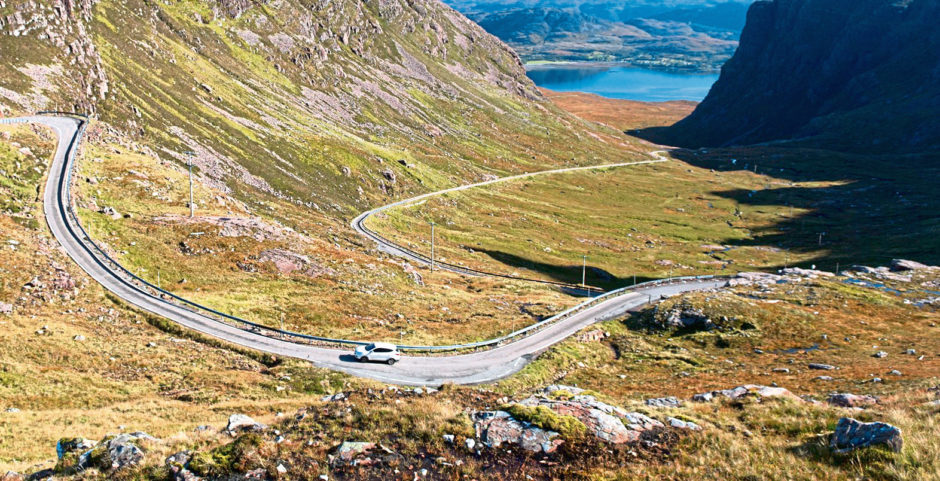Earlier this month, I was on the coast road in the north-west of Sutherland.
I hadn’t driven there for some time and was shocked at the changes I found.
The reason? The popularity of the North Coast 500.
Much has been written about the number of visitors now taking this circular tour of the north Highlands and the difficulties it has brought to local communities.
>> Keep up to date with the latest news with The P&J newsletter
Indeed, many tourists have bemoaned the lack of infrastructure along the route. The result is that few people spend the week or so on the road which would bring undoubted benefits to the fragile economies of the northern counties.
Instead, we see the road being traversed in one or even two-day trips, often by camper vans which clog up the single-track roads and bring little economic benefit, as they don’t need to use hotels and restaurants, or motor-cyclists, many of whom appear to use the route as a testing ground for the Isle of Man TT.
And don’t even start me on the lack of knowledge on the proper use of passing places!
The boom in popularity of the North Coast 500 has been fuelled by books, social media, online promotion – remarkably its official website is sponsored by no less than Aston Martin – and VisitScotland, which describes it as “Scotland’s Route 66”.
All very well. But without investment in places to eat and stay, the popularity of the route could soon collapse.
And in any case, does a circular coastal lap around the North of Scotland, starting and finishing at Inverness, for all its breathtaking beauty, really give visitors a taste of the real Highlands? Hardly.
So, here’s a proposal for a different tour of the north of Scotland: a Highland Clearances Trail, taking in not only Ross-shire, Sutherland and Caithness, but the whole of the Highlands, the north-east, the Northern Isles and the Hebrides.
Such a trail would take tourists to less visited and extremely interesting parts of our country, as well as highlighting a much-overlooked period in Scotland’s history.
Already, many descendants of the dispossessed of the Clearances come to Scotland searching for their ancestors.
Almost invariably, those interested in the story head for Sutherland, thanks to the notoriety of those particular clearances, with the huge statue of the Duke of Sutherland above Golspie a permanent presence and constant reminder of the events he oversaw.
My own ancestors were cleared from Culmailie, just south of Golspie, in the early years of the 1800s by Patrick Sellar, the duke’s factor, when he was granted the lands as his personal farm.
My forebears were moved to the coast of Caithness where, instead of the crofting they knew, they were forced to eke a meagre living from the sea.
The benefit of promoting a Clearances Trail would include taking visitors west to places such as Ulva, off Mull, where some of the most brutal clearances took place, to the Isle of Lewis, to Braes, on Skye, where the crofters (and their wives) made a stand against the authorities, as far east as Deeside in Aberdeenshire and as far south as Arran in the Firth of Clyde and Kintyre, as well as to the Northern Isles. Most Scots are unaware that clearances also took place on Hoy, in Orkney, and Fetlar, in Shetland.
These clearances, distant from Ross-shire and Sutherland, are often forgotten and a Clearances Trail would serve as a reminder of how widespread this dark period was in Scotland’s history.
A Highland Clearances Trail was first proposed by former Highland MSP Rob Gibson in a wee leaflet he produced way back in the early 1980s. Over the years, this expanded into a pamphlet and finally a book, published in 2006. Yet little has ever been done to promote the idea. Perhaps now is the time.
One of the most powerful historic sites in the Highlands, if not the whole of Scotland, is Croick Church on the Easter Ross-Sutherland boundary, some 10 miles inland from Ardgay.
It was in this churchyard, in 1845, that some 90 Glencalvie people, cleared from their homes to make way for sheep, gathered and camped overnight.
Many of them scratched their names or messages on the glass of the church windows, now alarmingly fragile and neglected.
The heart-breaking pleas can still just be seen today though I worry about their survival as unique examples of Scotland’s living history.
I visited for a couple of hours last month, and during the time I was there, at the height of the tourist season, there wasn’t another single visitor. A real pity.
A properly planned-out Clearances Trail would encourage visitors, particularly the Scottish diaspora, to learn something of Scotland’s almost forgotten history, as well as taking them to seldom-visited and hauntingly beautiful corners of the north of Scotland
It might also have the additional benefit of reducing the number of tourists currently clogging parts of the over-used North Coast 500. The clearances began in earnest some 250 years ago. So instead of the NC500, how about the HC250?


